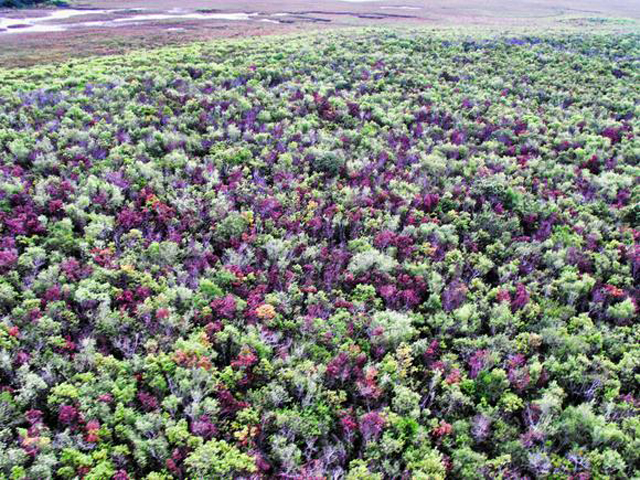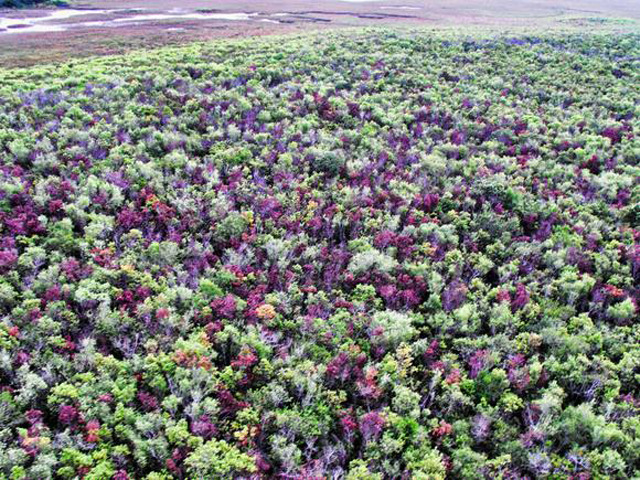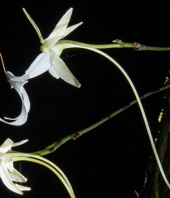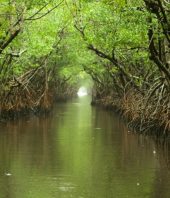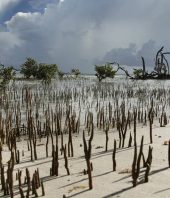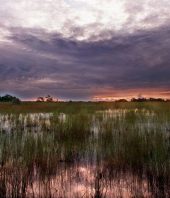A plant disease blazing through South Florida is killing off swamp bay trees, an important part of the architecture of the Everglades that provides food for a vast range of wildlife and traditional medicine for the Seminole Tribe.
Laurel wilt disease, a fungus carried by a beetle the size of a grain of rice, has been detected across more than 500 square miles of the Everglades, according to a forthcoming paper by state and federal scientists. The beetle, thought to have arrived from Asia in the Port of Savannah in packing crates, has hopscotched down the southeast coast, infecting avocado trees in the commercial groves of southern Miami-Dade County, reaching the wilderness of western Palm Beach County in 2012 and western Broward County in 2013.
"This is a huge, huge threat to the Everglades," said Jason Smith, associate professor of forest pathology at the University of Florida. "The loss of that tree canopy is going to totally change the ecosystem. It's arguably far more damaging to the Everglades than the pythons. These trees are dying rapidly in very, very large numbers."
Since first being detected east of Everglades National Park in 2011, the disease has spread across about one-sixth of the Everglades. Many canals through the southern Everglades are lined with dead swamp bay trees, said Tony Pernas, exotic plant management specialist with the National Park Service.
In Broward County, the disease has killed trees in the flat expanse of sawgrass and trees islands through which drivers pass on Alligator Alley. The amount of damage varies, with some tree islands showing a 10 percent loss of canopy and others, particularly in the southern Everglades, showing a 50 percent loss, said LeRoy Rodgers, lead scientist for the Land Management Bureau of the South Florida Water Management District.
"We're obviously very concerned," he said.
Although the disease turned up at the Loxahatchee National Wildlife Refuge in western Palm Beach County, it appears to have stalled there, without spreading beyond the few trees in which it was found, said Christen Mason, a biologist at the refuge.
The trees produce an abundance of blue and black berries, staples in the diets of wild turkeys, black bears, squirrels and other animals that inhabit the tree islands. The leaves serve as food for two butterflies, the spicebush swallowtail and the palamedes swallowtail.
They are a source of traditional medicine for the Seminole Tribe. In a column in the Seminole Tribune, tribal Chairman James Billie told of going as a child with his grandmother to gather leaves of the Tu lee tree for the Medicine Maker.
"The leaves have many uses, such as repelling evil spirits or easing the pain of arthritis," he wrote, expressing concern about the disease. "And the list goes on and on."
As the trees die off, they leave open spaces in the canopy that could easily be colonized by invasive Brazilian pepper or old-world climbing fern, which provide little food for wildlife.
"These tree islands don't have a lot of species that are capable of growing in these conditions," said Smith, of UF. "If these trees die, what do you replace them with? If you don't replace them with something, you have the potential for invasive species to take over."
The disease kills by choking the tree's tubes for transporting water and nutrients. There is no cure. A vaccine that allows trees to resist the fungus exists, but even avocado growers can't afford to inject every tree, and no one thinks this would be a practical solution.
There is one source of hope: A small percentage of trees appear to be resistant to the disease. Scientists have obtained funding to locate these trees and attempt to propagate them. This summer, a group of scientists will go to the Loxahatchee National Wildlife Refuge and other areas of the Everglades and look for the swamp bays still left standing.
In the avocado groves of southern Miami-Dade County, the second-largest crop in the country after California's, a helicopter makes routine flights over the 7,400 acres of groves in a survey for wilting or brown leaves, the signs of the disease, said Jonathan Crane, a UF tropical fruit crop specialist.
"We're very concerned," said Florida Agriculture Commissioner Adam Putnam. "This is one of a number of threats to iconic Florida crops. We're doing everything we can to save the avocado."
The state has received $5.4 million in the latest federal farm bill to fight laurel wilt in the avocado groves, among other diseases. The state has formed a working group, set out beetle traps to monitor the infestation and collaborated with the industry and UF to study the disease.
Among the symptoms: sudden leaf wilt, darkened wood and very quick death. Among the causes of the disease's spread is the transport of firewood, and authorities have asked the public to try to restrict themselves to local firewood.
Although the disease could also pose a threat to residential avocado trees, it's unclear whether it has spread to them yet. The Broward and Palm Beach extension services, which operate with UF to provide horticultural information to the public, said they have received no inquiries to indicate the presence of laurel wilt in backyard trees.
"That doesn't mean it isn't here," said Michael Orfanedes, commercial horticulture agent for the Broward Extension. "We've been watching this thing. People should be vigilant for it."
Source: Sun Sentinel
http://www.sun-sentinel.com/news/palm-beach/fl-everglades-tree-killer-20140518,0,5723587.story

